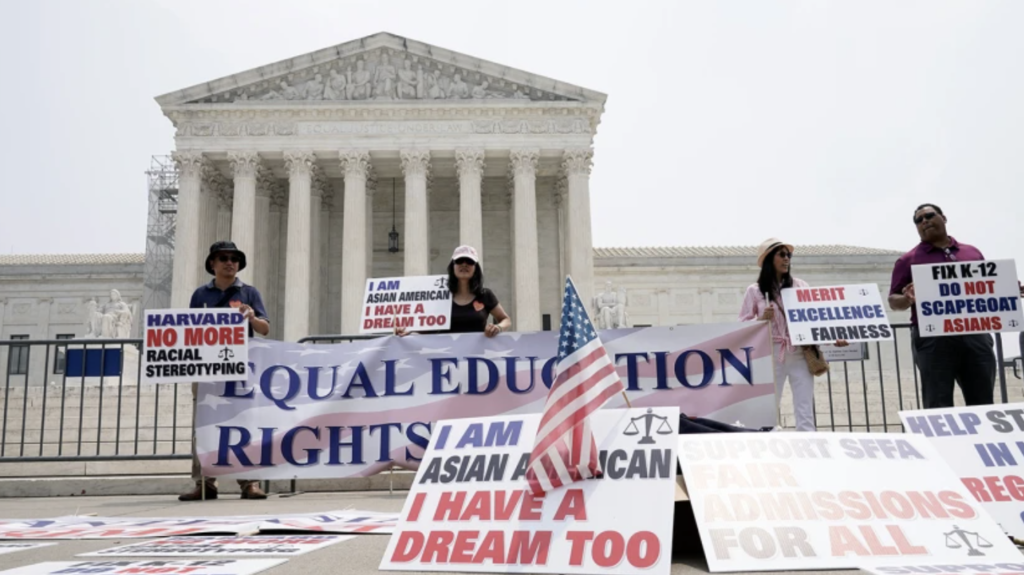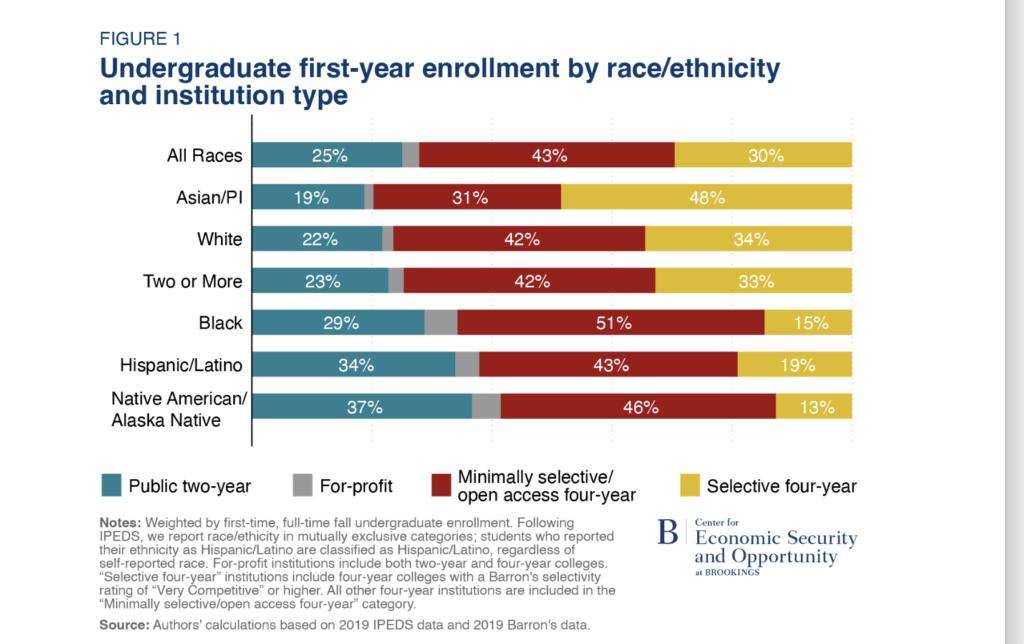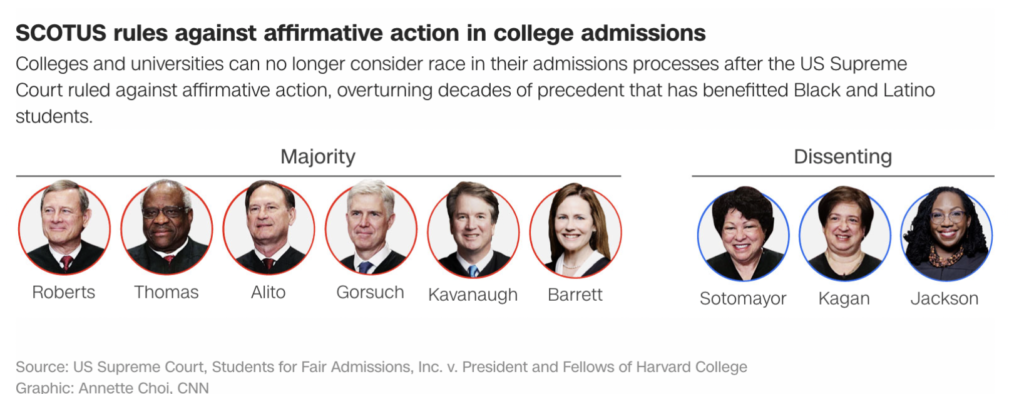On June 29, 2023, the U.S. Supreme Court in SFFA v. Harvard and SFFA v. University of North Carolina ruled against race-based affirmative action in college admissions, finding that Harvard’s and UNC’s consideration of applicants’ race to maintain diverse student bodies violated Title VI of the 1964 Civil Rights Act and the 14th Amendment’s Equal Protection Clause (1868). (“Race-Based Admissions in Higher Education: Addressing Systemic Inequality in American Society and Achieving True Equity | Department of English,” n.d.). These decisions reverse long-standing Supreme Court precedent dating from 1978, and threaten colleges’ efforts, which began during the 1954-1968 Civil Rights Movement, to increase educational access for underrepresented minorities through race-conscious admissions. (de Vogue, Cole, and Sneed 2023). SFFA opens age-old wounds involving America’s discriminatory history and the struggle for racial equity.

Universities’ push for racial equality in the 1960s to compensate for minorities’ unjust exclusion from elite education first received scrutiny in University of California v. Bakke (1978). (“Race-Based Admissions in Higher Education: Addressing Systemic Inequality in American Society and Achieving True Equity | Department of English,” n.d.). While Bakke found racial quotas which based admission exclusively on race unconstitutional, Justice Powell’s opinion permitted the holistic consideration of race, among other factors, to promote diverse campuses. (“How Did We Get Here? Affirmative Action in Admission to Selective Colleges,” n.d.). Supreme Court decisions in 2003, 2013 and 2016 addressing University of Michigan’s and University of Texas’s affirmative action policies followed Powell’s lead, upholding race-conscious admissions and rejecting White applicants’ claims that inclusion of race in colleges’ comprehensive review amounted to reverse racism, impairing their Constitutional rights. (Duignan 2023). By invalidating Harvard’s and UNC’s race-sensitive admissions and overturning judicial precedent, SFFA prohibits affirmative action in public and private universities, enforcing colorblind admissions. (Debusmann Jr. 2023). Justice Roberts’s opinion pointed to Justice O’Connor’s 2003 Grutter decision which supported affirmative action, but cautioned that racial preferences must end at some point. (Ramirez 2024). SFFA softened its decision, however, by excluding military academies and permitting consideration of racial factors that influence applicants’ character: “‘Nothing in this opinion should be construed as prohibiting universities from considering an applicant’s discussion of how race affected his or her life.’” (Duignan 2023; SFFA v. Harvard).
The 14th Amendment and the 1964 Civil Rights Act sought to protect Black Americans and bar discrimination following America’s long history of slavery, disenfranchisement and legally-mandated segregation. (“How Did We Get Here? Affirmative Action in Admission to Selective Colleges,” n.d.). It was not until 1954 that the Supreme Court invalidated state laws requiring racially segregated public schools in Brown v. Board of Education, dismantling the “separate but equal” doctrine established by Plessy v. Ferguson (1896), and paving the way for integration. (“Race-Based Admissions in Higher Education: Addressing Systemic Inequality in American Society and Achieving True Equity | Department of English,” n.d.). Martin Luther King, Jr.’s peaceful advocacy, and the 1965 Voting Rights Act empowering Black voters, contributed to the Civil Rights Movement’s fight for racial justice. Under the 14th Amendment and Civil Rights Act, race-based policies must be narrowly tailored to a compelling state interest and receive strict scrutiny. (“How Did We Get Here? Affirmative Action in Admission to Selective Colleges,” n.d.). Yet, the affirmative action plaintiffs cite these same laws – intended to support historically marginalized minorities – to undermine policies which seek to remedy inequality and increase access for these underserved groups. (“Race-Based Admissions in Higher Education: Addressing Systemic Inequality in American Society and Achieving True Equity | Department of English,” n.d.). By characterizing affirmative action as reverse discrimination, these cases arguably turn the original purpose of the 14th Amendment and Civil Rights Act on its head.
The difference between SFFA’s Asian American plaintiffs and the privileged White Americans pursuing prior cases influenced the alternative outcome. (Shehada 2021). The Asians’ academic credentials outshined other ethnic groups, and, similar to Black Americans, Asians suffer from America’s unequal racial hierarchy. (Shehada 2021; Totenberg 2023). Asian applicants’ rejection underscored biased racial stereotyping in admissions: Harvard penalized Asians with lower numbers on the “personal ratings” scale relative to White applicants. (de Vogue, Cole, and Sneed 2023).

SFFA has intensified lingering debates regarding affirmative action and how to overcome systemic social and economic disadvantages caused by America’s racist history. The decision reflects the counter-reaction to well-intentioned efforts to promote inclusion and opportunity. Universities’ battle to address America’s legacy of exclusion – UNC did not admit Black undergraduates until 1955 – triggers resistance and claims that the laws overcompensate for prior violations, adversely affecting non-minorities. (Totenberg 2023). By allowing a limited consideration of race, SFFA provides some flexibility. Merit-based admissions cannot ignore the deep scars and handicaps arising from America’s past of state-mandated discrimination. (de Vogue, Cole, and Sneed 2023). As Justice Jackson, the Court’s first Black female justice, notes in her dissent: “‘deeming race irrelevant in law does not make it so in life…[the majority] has detached itself from this country’s actual past and present experiences.’” (de Vogue, Cole, and Sneed 2023). Jackson highlights the myth of a colorblind America. Public opinion on affirmative action remains mixed – Trump championed SFFA while Biden scorned the decision – but research supports that race-consciousness most effectively increases diversity. (Debusmann Jr. 2023). SFFA has broad ramifications beyond higher education, subjecting racial-preferences in other institutions to challenge, including in primary and secondary schools as well as employment settings. (Totenberg 2023). Understanding the historical origins of SFFA provides insight regarding the complexity of the evolving legal landscape and public perception surrounding affirmative action. America must continue to embrace diversity, equity and inclusion, fostering equality while ensuring fairness, and welcoming all regardless of race or ethnicity.

Sources and citations:
Tier 1
- https://english.umd.edu/research-innovation/journals/interpolations/fall-2023/race-based-admissions-higher-education
- “Race-Based Admissions in Higher Education: Addressing Systemic Inequality in American Society and Achieving True Equity | Department of English.” n.d. English.umd.edu. https://english.umd.edu/research-innovation/journals/interpolations/fall-2023/race-based-admissions-higher-education.
- https://digitalcommons.law.seattleu.edu/sulr/vol47/iss4/7/
- Ramirez, Steven. 2024. “Students for Fair Admissions: Affirming Affirmative Action and Shapeshifting towards Cognitive Diversity?” Seattle University Law Review 47 (4): 1281. https://digitalcommons.law.seattleu.edu/sulr/vol47/iss4/7/.
- https://www.researchgate.net/profile/Mohammed-Shehada/publication/375597939_Considerations_of_Race_in_Admissions_-_the_Case_of_SFFA_v_Harvard_University/links/6551eb53b86a1d521bdf95f8/Considerations-of-Race-in-Admissions-the-Case-of-SFFA-v-Harvard-University.pdf
- Shehada, Mohammed. 2021. “Considerations of Race in Admissions – the Case of SFFA v. Harvard University”. Georgetown University| School of Continuing Studies. https://www.researchgate.net/profile/Mohammed-Shehada/publication/375597939_Considerations_of_Race_in_Admissions_-_the_Case_of_SFFA_v_Harvard_University/links/6551eb53b86a1d521bdf95f8/Considerations-of-Race-in-Admissions-the-Case-of-SFFA-v-Harvard-University.pdf
Tier 2
- https://www.npr.org/2023/06/29/1181138066/affirmative-action-supreme-court-decision
- Totenberg, Nina. 2023. “Supreme Court Guts Affirmative Action, Effectively Ending Race-Conscious Admissions.” NPR. June 29, 2023. https://www.npr.org/2023/06/29/1181138066/affirmative-action-supreme-court-decision.
- https://www.supremecourt.gov/opinions/22pdf/20-1199_hgdj.pdf
- Supreme Court of the United States. 2023. “Students for Fair Admissions, Inc. V. President and Fellows of Harvard College.” Supreme Court of the United States. https://www.supremecourt.gov/opinions/22pdf/20-1199_hgdj.pdf.
- https://www.air.org/how-did-we-get-here-affirmative-action-admission-selective-colleges
- “How Did We Get Here? Affirmative Action in Admission to Selective Colleges.” n.d. American Institutes for Research. https://www.air.org/how-did-we-get-here-affirmative-action-admission-selective-colleges.
Tier 3
- https://www.britannica.com/topic/Students-for-Fair-Admissions-Inc-v-President-and-Fellows-of-Harvard-College
- Duignan, Brian. 2023. “Students for Fair Admissions, Inc. V. President and Fellows of Harvard College | Definition, Questions, Grutter v. Bollinger, Affirmative Action, & Facts | Britannica.” Www.britannica.com. August 14, 2023. https://www.britannica.com/topic/Students-for-Fair-Admissions-Inc-v-President-and-Fellows-of-Harvard-College.
- https://www.bbc.com/news/world-us-canada-65886212
- Debusmann Jr., Bernd. 2023. “Affirmative Action: US Supreme Court Overturns Race-Based College Admissions.” BBC News, June 29, 2023, sec. US & Canada. https://www.bbc.com/news/world-us-canada-65886212.
- https://www.cnn.com/2023/06/29/politics/affirmative-action-supreme-court-ruling/index.html
- Vogue, Ariane de, Devan Cole, and Tierney Sneed. 2023. “Supreme Court Guts Affirmative Action in College Admissions | CNN Politics.” CNN. June 29, 2023. https://www.cnn.com/2023/06/29/politics/affirmative-action-supreme-court-ruling/index.html.
- https://generalcounsel.uoregon.edu/news/fisher-vs-utexas
- “U.S. Supreme Court Upholds Use of Race-Conscious Programs in Higher Education | General Counsel.” n.d. Generalcounsel.uoregon.edu. https://generalcounsel.uoregon.edu/news/fisher-vs-utexas.
- https://www.foxnews.com/politics/supreme-court-rejects-affirmative-action-ruling-universities-using-race-admissions-decisions
- Anders Hagstrom, Brianna Herlihy. 2023. “Supreme Court Rejects Affirmative Action in Ruling on Universities Using Race in Admissions Decisions.” Fox News. June 15, 2023. https://www.foxnews.com/politics/supreme-court-rejects-affirmative-action-ruling-universities-using-race-admissions-decisions.

Comments are closed.